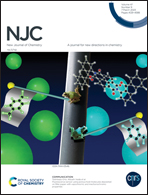From CO2 to CS2: a theoretical investigation of the cycloaddition to aziridines mediated by metal-free porphyrin-based catalytic systems†
Abstract
A detailed computational analysis of the synthesis of thiazolidine-2-thiones by CS2 insertion into three membered aziridine rings is here reported. DFT studies highlighted the feasibility of the atom-efficient process by employing either the metal-free binary TPPH2/TBACl system or bifunctional TPPH4Cl2 molecules as the catalytic species. Detailed investigations into the mechanism promoted by the TPPH2/TBACl system indicated, as in the analogous cycloaddition of CO2, the pivotal role of the adduct between TPPH2 and TBACl salts in the synthesis of both N-aryl and N-alkyl thiazolidine-2-thiones. The latter species can be also obtained by using the eco-compatible TPPH4Cl2 catalyst, which is able to simultaneously activate CS2 and aziridine molecules. The comparison of the overall energy gains of the reaction between aziridines and CS2 with respect to the same process involving CO2 revealed that the formation of thiazolidine-2-thiones is more favoured than the synthesis of oxazolidin-2-ones paving the way to develop efficient and eco-compatible synthesis of thiazolidine-2-thiones.



 Please wait while we load your content...
Please wait while we load your content...